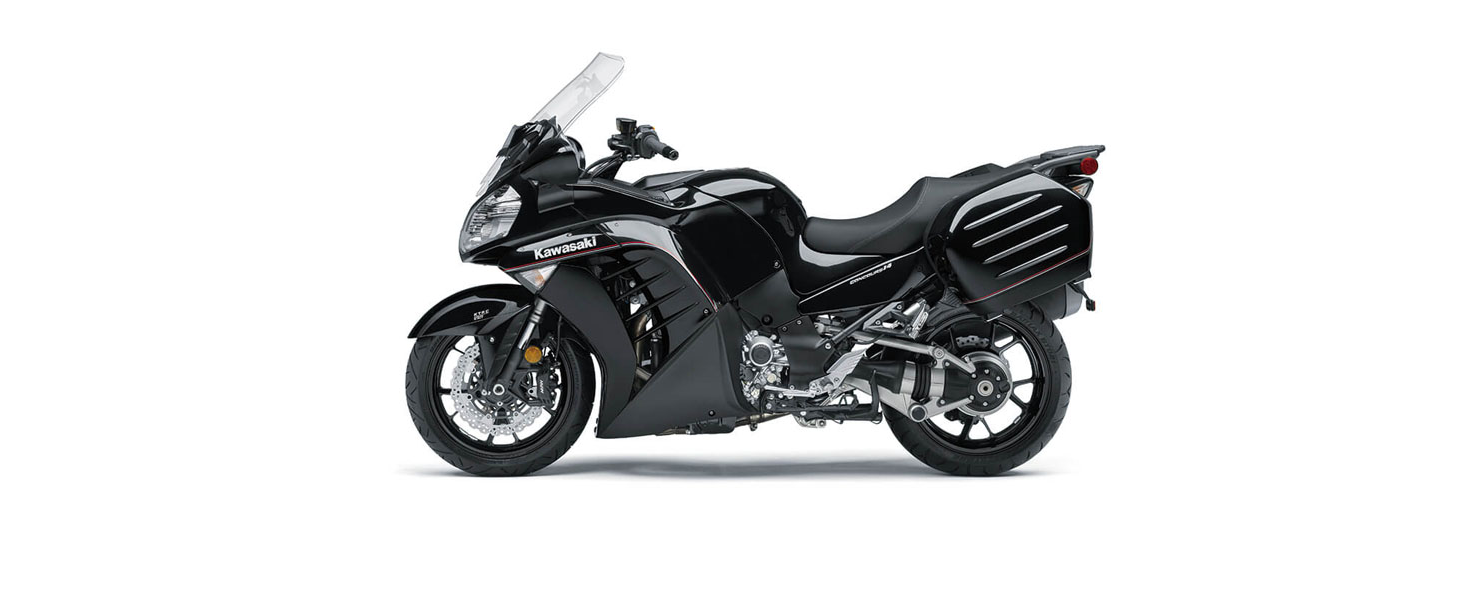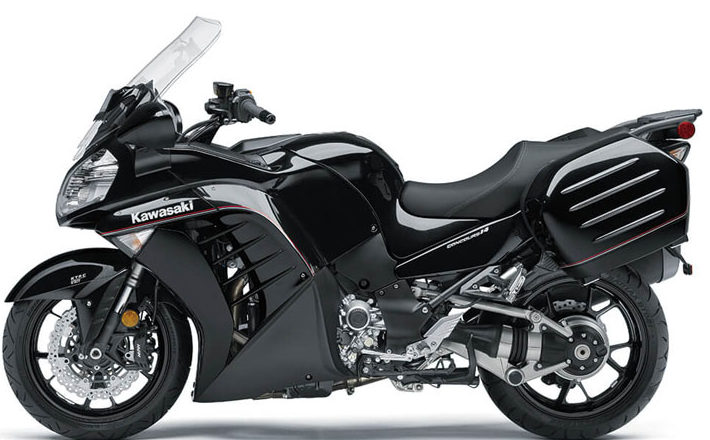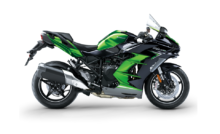2022 Kawasaki Concours 14ABS Read Owner’s Manual




2022 Kawasaki CONCOURS 14ABS Read Owner’s Manual


Read Owner’s Manual
Read this Owner’s Manual carefully before riding so that you will be thoroughly familiar with the proper operation of your motorcycle’s controls, its features, capabilities, and limitations. This manual offers many safe riding tips, but its purpose is not to provide instruction in all of the techniques and skills required to ride a motorcycle safely.
Training
Kawasaki strongly recommends that all operators of this vehicle complete a suitable motorcycle rider training program to learn the proper skills and techniques necessary for safe motorcycle operation.
Daily Checks and Periodic Maintenance
It is important to keep your motorcycle properly maintained and in safe riding condition. Inspect your motorcy cle before every ride and carry out all periodic maintenance. See the Daily Checks section and the Periodic Maintenance section in the MAINTENANCE AND ADJUSTMENT chapter for more information.
WARNING
- Failure to perform these checks or to correct a problem before operation may result in serious damage or an accident. Always perform daily checks before operation.
- To ensure your motorcycle is serviced using the latest servicing information, it is recommended that an authorized Kawasaki Dealer performs the periodic maintenance as directed in the Owner’s Manual.
- If you notice any irregular operating conditions, have your motorcycle thoroughly checked at an authorized Kawasaki dealer as soon as possible.
Loading and Accessories Information
WARNING
Incorrect loading, improper installation or use of accessories, or modification of your motorcycle may result in an unsafe riding condition. Before you ride the motorcycle, make sure it is not overloaded and that you have followed these instructions.
Maximum Load
The weight of rider, passenger, baggage, and accessories must not exceed 228 kg (503 lb).
- With the exception of genuine Kawasaki Parts and Accessories, the Kawasaki has no control over the design or application of accessories. In some cases, improper installation or use of accessories, or motorcycle modification, will void the motorcycle warranty: can negatively affect performance, stability, and safety; and can even be illegal.
- In selecting and using accessories, and in loading the motorcycle, you are personally responsible for your own safety and the safety of other persons involved.
NOTE
Kawasaki Parts and Accessories have been specially designed for use on Kawasaki motorcycles. We strongly recommend that all parts and accessories you add to your motorcycle be genuine Kawasaki components.
Because a motorcycle is sensitive to changes in weight and aerodynamic forces, you must take extreme care in carrying cargo, passengers, and/or in fitting additional accessories. The following general guidelines have been prepared to assist you in making your determinations.
Passenger
- Never carry more than one passenger.
- The passenger should only sit on the pillion.
- Any passenger should be thoroughly familiar with motorcycle operations. The passenger can affect control of the motorcycle by im- proper positioning during cornering and sudden movements. It is important that the passenger sits still while the motorcycle is in motion and not interfere with the operation of the motorcycle. Do not carry ani- mals on your motorcycle.
- Do not carry passengers unless passenger footpegs are installed. Instruct any passenger before riding to keep his or her feet on the passenger footpegs and hold on to the operator or grab the rail. Do not carry a passenger unless he or she is tall enough to reach the footpegs with their feet.
Baggage and Luggage
- All baggage should be carried as low as possible to reduce the effect on the motorcycle’s center of gravity. Baggage weight should also be distributed equally on both sides of the motorcycle. Avoid carrying baggage that extends beyond the rear of the motorcycle.
- Baggage should be securely attached. Make sure that the baggage will not move around while you are riding. Recheck baggage security as often as possible (not while the motorcycle is in motion) and adjust as necessary.
- Do not carry heavy or bulky items on a luggage rack. It is designed for light items, and overloading can affect handling due to changes in weight distribution and aerodynamic forces
Accessories
- Do not install accessories or carry baggage that impairs the performance of the motorcycle. Make sure that you have not adversely affected any lighting components, road clearance, banking capability (.e., lean angle), control operation, wheel travel, front fork movement,or any other aspects of the motor- cycle’s operation.
- The weight attached to the handlebars or front fork will increase the mass of the steering assembly and can result in an unsafe riding condition.
- Fairings, windshields, backrests, and other large items have the capability of adversely affecting the stability and handling of the motorcycle, not only due to their weight, but also due to the aerodynamic force acting on these surfaces while the motorcycle is in operation. Poorly designed or installed items can result in an unsafe riding conditions.
Other Load
- This motorcycle is not intended to be equipped with a sidecar or to be used to tow any trailers or other vehicles. Kawasaki does not manufacture sidecars or trailers for motorcycles and cannot predict the effects of such accessories on handling or stability, but can only warn that the effects can be adverse and that Kawasaki cannot assume responsibility for the results of such unintended use of the motorcycle.
- Furthermore, any adverse effects on motorcycle components caused by the use of such accessories will not be remedied under warranty.
If You are Involved in an Accident
- Make sure of your own safety first. Determine the severity of any injuries and call for emergency assistance if needed. Always follow applicable laws and regulations if any other person, vehicle or property is involved.
- Do not attempt to continue riding without first evaluating your motorcycle’s condition. Inspect for fluid leaks, check critical nuts and bolts, and check the handlebars, control levers, brakes, and wheels for damage and proper function. Ride slowly and cautiously – your motorcycle may have suffered damage that is not immediately apparent. Have your motorcycle thoroughly checked at a Kawasaki dealer as soon as possible.
Safe Operation
The following should be carefully observed for safe and effective vehicle operation.
Carbon Monoxide Hazard
DANGER
- Exhaust gas contains carbon monoxide, a colorless, odorless poisonous gas. carbon monoxide can cause Inhaling serious brain injury or death.
- DO NOT run the engine in enclosed areas. Operate only in a well-ventilated area.
Fueling
WARNING
- Gasoline is extremely flammable and can be explosive under certain conditions.
- To avoid possible fire or explosion, turn the ignition switch off. Do not smoke. Make sure the area is well ventilated and free from any source of flame or sparks; this includes any appliance with a pilot light.3
Never Ride with Drugs or Alcohol
Alcohol and drugs impair your judgment and reaction time. Never consume alcohol or drugs before or while riding motorcycles.
Protective Gear and Clothing
Helmet
- Kawasaki strongly recommends both the operator and passenger wear a
- DOT-approved helmet even if this is not a legal requirement.
- Make sure that your helmet fits cor- rectly and is properly fastened. Choose a motorcycle helmet that meets DOT safety standards. Ask your motorcycle dealer to advise you if necessary.
Eye Protection
Always use eye protection. If your helmet does not have a visor installed, wear goggles.
Gloves
Wear gloves that have suitable protection for your hands, especially against abrasion.
Clothing
Wear the riding wear which have protectors for each parts of the body (chest, shoulders, back, elbows and knees, etc.) as much as possible, or wear protectors for them. Always wear a long-sleeved jacket and long trousers which are abra- SIon resistant and keep you warm. Wear clothing that allows freedom of movement. Avoid wearing clothes that have loose cuffs or other fastenings which could interfere with the con- trols of your motorcycle. Wear bright, highly visible clothing.
Boots
Wear proper protective boots that fit properly and do not interfere with gear shifting or braking.
Safe Riding Techniques
Keep Hands on Handlebars When riding always keep both hands on the handlebars and both feet on the footpegs. Removing your hands from the handlebars or feet from the foot pegs while riding can be hazardous. If you remove even one hand or foot, you reduce your ability to control the motorcycle.
Look Over Your Shoulder
Before changing lanes, look over your shoulder to make sure the way is clear. Do not rely solely on the rear view mirror; you may misjudge a vehicle’s distance and speed, or you may not see it at all.
Accelerate and Brake Smoothly
In general, your actions should be smooth as sudden acceleration, braking or turning may cause loss of control, especially when riding in wet conditions or on loose road surfaces when the ability to maneuver will be reduced.
Select Correct Gear Speeds
When going up steep slopes, shift to a lower gear so that there is the power to spare rather than overloading the engine.
Use Both Front and Rear Brakes
When applying the brakes, use both the front and rear brakes. Applying only one brake for sudden braking may cause the motorcycle to skid and lose control.
Use Engine Brake
When going down long slopes, help control vehicle speed by closing the throttle so that the engine can act as an auxiliary brake. Use the front and rear brakes for primary braking.
Riding in Wet Conditions
Rely more on the throttle to control vehicle speed and less on the front and rear brakes. The throttle should also be used judiciously to avoid skidding the rear wheel from too rapid acceleration or deceleration. Braking performance is also reduced in wet conditions Carefully ride at a slow speed and apply the brakes several times to help dry and restore them to normal operating performance.
Ride Prudently
Riding at the proper speed and avoid- ing unnecessarily fast acceleration is important not only for safety and low fuel consumption but also for long ve- hicle life and quieter operation.
Riding on Rough Roads
Exercise caution, slow down and grip the fuel tank with the knees for better stability.
Acceleration
When quick acceleration is necessary to pass another vehicle, shift to a lower gear to obtain the necessary power.
Downshifting
To avoid engine damage and rear wheel lock-up do not downshift at high rpm. Avoid Unnecessary Weaving Unnecessary for the safety of both the rider and other motorists. weaving jeopardizes
Additional Considerations for High-Speed Operation
WARNING
Handling characteristics of a motorcycle at high speeds may vary from those you are familiar with at legal highway speeds. Do not attempt high-speed operation unless you have received sufficient training and have the required skills. Do not operate at high speeds on public roads.
Brakes
The importance of the brakes, especially during high-speed operation, cannot be overemphasized. Check to see that they are correctly adjusted and functioning properly.
Steering
Looseness in the steering can cause a loss of control. Check to see that the handlebars turn freely but have no play.
Tires
High-speed operation is hard on tires, and good tires are crucial for safe riding. Examine their overall condition, in- flate them to the proper pressure and check the wheel balance.
Fuel
Have sufficient fuel for the high fuel consumption during high-speed operation.
Engine Oil
To avoid engine seizure and the resulting loss of control, make sure that the oil level is at the upper-level line.
Coolant
To avoid overheating, check that the coolant level is at the upper-level line.
Electrical Equipment
Make sure that the headlight, tail/brake light, turn signals, horn, etc., all work properly.
Miscellaneous
Make sure that all nuts and bolts are tight and that all safety-related parts are in good condition.
Recent Posts
VW Jetta Engine Fuse Box Diagram
Access the comprehensive 2010-2018 VW Jetta Passenger Fuse Box Diagram to troubleshoot electrical issues effectively.…
VW Jetta Passenger Fuse Box Diagram
Explore the comprehensive VW Jetta Passenger Fuse Box Diagram to troubleshoot electrical issues effectively. Understand…
2023 Ford F-150 Lightning Fuse Box Diagram
Under Hood Fuse Box Location Remove the front luggage compartment cover. Under Hood Fuse Box…
2022 Kawasaki NINJA H2 SX SE Brake Lever Adjuster Owner’s Manual
2022 Kawasaki NINJA H2 SX SE Brake Lever Adjuster Owner's Manual NOTICE Only adjust the front…
2023 Land Rover Range Rover Evoque Exiting The Vehicle Owners Manual
2023 Land Rover Range Rover Evoque Exiting The Vehicle SINGLE LOCKING WARNING Before exiting the…
2023 Land Rover Range Rover Evoque Front Seats Owners Manual
2023 Land Rover Range Rover Evoque Front Seats FRONT SEAT SAFETY Make sure to read…
